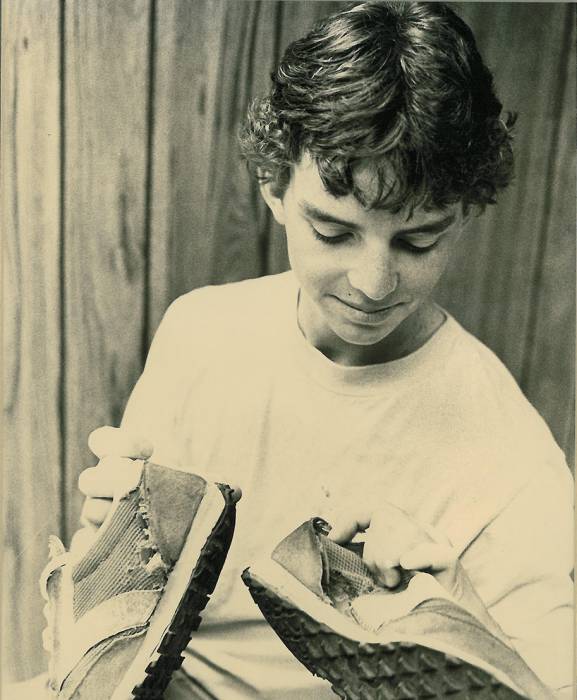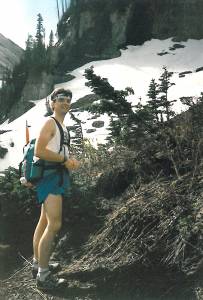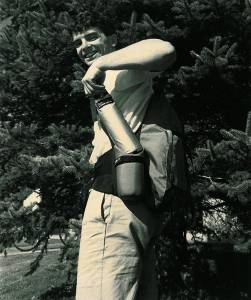Moving fast and light has defined Bryce Thatcher’s career. We caught up with the UltrAspire founder to learn how he helped shape a movement.
Bryce Thatcher has set speed records on the White Rim trail, in the Winds, and, the grandest of all, a longstanding record up the Grand Teton. Along the way, Thatcher helped build the foundation for an entire market dedicated to hydrating the pursuit of fast and light.
And in that pursuit, Thatcher founded the brand UltrAspire (and Ultimate Direction, but more on that later).
Thatcher’s passion for mountain sports helped evolve the way we pursue our own outdoor passions and put hydration products on the map.
On a frosty August morning in the summer of 1983, Thatcher donned a cotton T-shirt, a pair of nylon shorts, and lightweight running shoes with intent to “be off the top of the Grand by noon.” With no food, no water, and no tools for aid, Thatcher shot out of the lot, only stopping briefly to sip water from the streams.
Thatcher stormed to the top of the Park, signed the register, and spilled back into the Lupine Meadows parking lot. He stopped the clock: 3:06. It was a record time that endured nearly 30 years before one Kilian Jornet nabbed the top spot in 2012 (with a time of 2:54).
We caught up with one of the first athletes to push into the sport of FKTs — before they were even a thing.
Interview: UltrAspire Founder Bryce Thatcher
GearJunkie: Can you tell us about your fastpacking record on the Highline Trail in the Wind River Range and your role in the development of fastest known times (FKTs)?
Thatcher: So I tackled the Highline with a longtime friend, Jim Knight. Jim coined the term “fastpacking,” defining it as taking a trail that most people do in a week and compress it down to a shorter period, through gear selection and going as light as you safely can. At that time, I had already launched Ultimate Direction, but there weren’t any running packs with a large enough capacity to hold enough gear.
I was also in college studying things like biomechanics, ergonomics, and how the body moves. These two things helped me realize we could make a larger-volume pack that you could still run with. I developed an Ultimate Direction pack called the Voyager, and that is what Jim and I used to help us tackle this FKT.
Our goal was to carry everything 100% self-supported and have it all accessible on the go. We knew we wanted the record, but our main goal was to enjoy a section of trail without having to take a week off of work to do it.
Back in those days, the idea of carrying lots of gear while still moving quickly was new, so it was a lot to figure out. Ultimately, it took us 38 hours from point to point (including sleep time) and was documented as an “FKT,” even though FKT wasn’t really a thing yet.

What drew you toward setting FKTs? What was your motivation and who were your peers?
The idea of FKT for me was self-driven. This was decades before social media, so I wasn’t aware of what was going on outside of my peers. At first, it was to improve my fitness and watching my diet. Down the road, it came to doing those things as well as developing specific gear that would help perform better in the mountains.
I spent a lot of time with Jim Knight, Kim Miller, and Dana Miller (not related to Kim). Again, Jim was the originator of the term “fastpacking” and the idea of being fast and self-supported.
Kim Miller was my friend since I was a teenager, and he was a big part of my Grand Teton FKT. He was a great rock climber, and I was really fast so I would carry the gear, and we would run into the mountain and climb it.
Dana Miller ended up joining me as the VP of Ultimate Direction, and our adventures were solely just to improve our fitness and abilities on the trails.
The first hydration pack came from a need. How could I be faster in the mountains? How could I spend less time stopping so that I can move faster? I was motivated by that feeling of self-improvement and making my time faster.
FKT is having a moment now. Why do you think that is?
This is simply my opinion, but I feel that right now FKT is being pushed forward by runners who have done really well in ultra events and have either wanted to challenge themselves differently or are tired of paying the fees associated with ultra events. I remember it used to be like $20 to sign up for an event and that included a T-shirt. Now we’re seeing $200-500 entry fees.
Twenty years ago, the fastest ultrarunners were typically in their 40s, and that’s simply from experience on the trails. They knew how to get through things, how to take care of their body, carry the right gear, and deal with situations as they would encounter. But now, I think that younger ultrarunners are coming into the sport looking for the challenge and the next thing.
A lot of joy comes tackling a section of trail that you planned, trained for, and executed on your own. You have to work through whatever crap comes your way. Anything that can go wrong will at these long distances, but that is part of the journey is figuring it out.
I think being able to dig that deep and move from the physical to the mental and the spiritual state of mind to get through the hard times gives people a lot of strength that they can take and utilize in other areas of their lives.
Right! Take for example Kilian Jornet — an accomplished nordic skier, cyclist, and runner — he’s followed in your path. How much do you attribute the success of an FKT to speed versus cross-discipline skills?
So first off, I have to say Kilian is a tremendous athlete and a force to be reckoned with.
Regarding cross-discipline skills, I was a cross-country skier in college. It was a great way to keep my cardio fitness. So I am a big believer in the benefits of cross-training. It gives you a mental and physical break from the jarring of running.
I’ve gone from skiing to snowshoeing to mountain biking to time trialing on bikes to running — all of which are powered by the same engine, human-powered, and are dependent on the aerobic system.
One of my favorite parts of my Grand Teton FKT was trying to figure out the type of training I needed to handle the types of terrain I was going to encounter. I’ve never had any joint or leg issues, and I think that can be attributed to cross-training in my offseasons.
How much of an FKT is attributed to lighter gear, nutrition, and a more disciplined application of science?

I ran the Grand Teton in 1983 with a cotton T-shirt, road running shoes, and a pair of nylon shorts — and that is it. There was no such thing as energy foods, no coaches or coaching, no way to carry your gear effectively, and no specialists.
Since that time, people have been able to introduce these aspects, and the evolution of them all collectively work to make athletes better. The athletes in general are a higher caliber than they used to be. Both of these things have their place, and each development helps us as athletes to perform better.
Speaking of gear, you run a sports pack/hydration company, UltrAspire. But this isn’t your first hydration rodeo, either. Many people may not know that you also founded Ultimate Direction and designed for Nathan Sports.
I launched Ultimate Direction back in 1985 and ran it through 1999. I went to Nathan in 2003 and did design work for them until 2010. When I started at Nathan, they didn’t have any vests, but they had some bottle packs with foam holsters. Jon Reichlin, a great guy, had purchased Nathan Sports from Michael Nathan.
Nathan Sports back in that time was a second-tier brand. Jon then brought me in to do all of the design work, photography, imaging, naming the products, and brought the athletes to the table. So I was at Nathan during a very crucial development stage.
What was hydration like in 1985?
It was nonexistent. The idea of hydration on the go was something we were working on for the last 5 years in 1990. But we needed a way to not only carry our gear but access it quickly, and that option just was not on the table back then prior to us.

My first prototypes were waist packs with a bottle on them. The whole idea was hydration on the go so you don’t ever have to stop. After we figured out the hydration component, I moved on to figuring out how to add nutrition to the mix as well. It was all based on ease of access so that the athlete can focus on performance. That was the premise that Ultimate Direction was founded on. There was nothing like it on the market.
The first race vest, which is the popular term now, was actually created out of a need for winter use. Ultimate Direction was founded in Rexburg, Idaho, where it can get very cold in winter. We wanted to figure out how to keep fluids on hand and stop them from freezing during winter sports. This would have been around 1990.
Can you share some of your failures on the way to successful products?
Failure is part of the process. To this day, I still develop things that I go back later to fix and change, and that leads me to the next thing.
For example, I tried pressurized hydration from the idea that creating back pressure in the bladder would allow for quicker water flow. We launched that for about a year and had some failures with it; I think we were a bit too early on the scene with that. But the idea took form later on, so I don’t think that it was a total loss.
My philosophy in design is keeping everything as simple and intuitive as possible. Success is that transition that goes from simple to complex and back to simple … while keeping all the features that the complexity brought to the table.
Do you see yourself as the founder of modern hydration or moving fast and light in the mountains? Are the two exclusive?
As far as hydration is concerned, I think that would be an appropriate thing to say. Moving fast and light in the mountains I would consider myself one of the founders, but not solely. There were definitely other people working to be light and fast in the mountains.
So why after the success of Ultimate Direction did you leave to help build Nathan and then start UltrAspire? What freedom does UltrAspire give you and give us that others are not doing?
Back in the UD days, we were doing the manufacturing in two factories: one in South Dakota and the other in Rexburg. We had 100 employees in each factory, and we were making everything ourselves.
We were doing everything we could do to simplify the process of actually making the packs. Our material costs kept going up and labor cost continued going up, but I loved the idea of U.S. manufacturing. All of our competitors went overseas and were able to undercut us grossly on price. I made the decision to sell to a larger company who could make the necessary manufacturing adjustments to ensure the brand continued to be successful.
At Nathan, while I designed for the athlete, I had to answer accountants and big business; this limited developing new concepts because they weren’t sure if there was a need for what we were developing. That hindered my ability to explore things that could’ve been new and innovative.
I wanted to go back to a company where I had more freedom to focus on driving the industry forward with products that solve problems that athletes face. Obviously, we have to stay in business, but it is more important to me that we explore new problem spaces to keep progress moving forward. I love pushing the envelope.

I’ve been using the XT hydration pack for a few months. It really speaks to moving fast and light in the mountains. Can you share any problem spaces should we look forward to being solved at UltrAspire?
Glad you have enjoyed that pack! The whole idea of the Bryce XT was building a pack that is multisport and multiuse for a lot of things. I wanted to go away from weight, not to make the packs heavy, but to make sure I’m pushing the durability factor up the scale to make sure you get years and years out of it.
I still take great pride when I am out hiking and I see people running in old Ultimate Direction products. I want longevity and practicality out of products.
As for evolution, I think we will see more people combine sports into one. Maybe they mountain bike to the base of the mountain, run up, and then make the final climb to the summit and then reverse. I want to be sure I have products on the table for those people.








